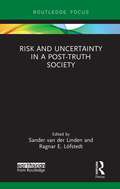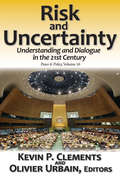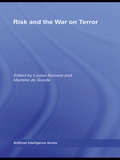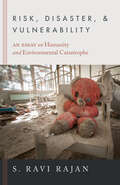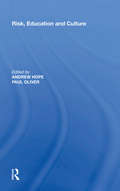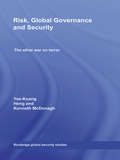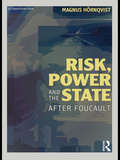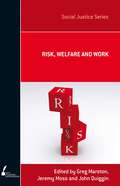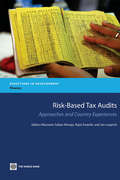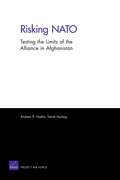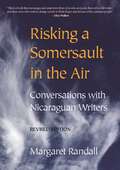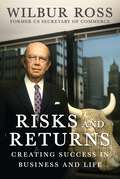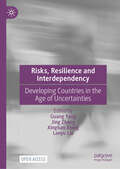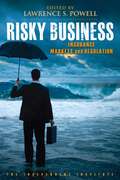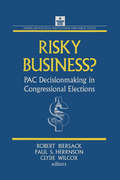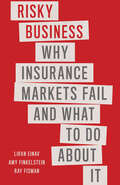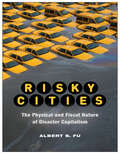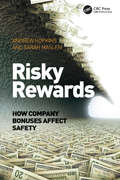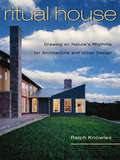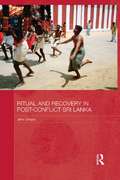- Table View
- List View
Risk and Uncertainty in a Post-Truth Society (Earthscan Risk in Society)
by Sander van der Linden Ragnar E. LöfstedtThis edited volume looks at whether it is possible to be more transparent about uncertainty in scientific evidence without undermining public understanding and trust. With contributions from leading experts in the field, this book explores the communication of risk and decision-making in an increasingly post-truth world. Drawing on case studies from climate change to genetic testing, the authors argue for better quality evidence synthesis to cut through the noise and highlight the need for more structured public dialogue. For uncertainty in scientific evidence to be communicated effectively, they conclude that trustworthiness is vital: the data and methods underlying statistics must be transparent, valid, and sound, and the numbers need to demonstrate practical utility and add social value to people’s lives. Presenting a conceptual framework to help navigate the reader through the key social and scientific challenges of a post-truth era, this book will be of great relevance to students, scholars, and policy makers with an interest in risk analysis and communication.
Risk and Uncertainty: Understanding and Dialogue in the 21st Century (Peace And Policy Ser. #Vol. 16)
by Olivier Urbain Kevin P. Clements EDITORSConflict transformation requires, at minimum, a capacity to listen and respond constructively to those who are being hurt intentionally or unintentionally by others. This compendium attempts to understand the ways in which borders and boundaries are manifestations of less visible dynamics in individual or collective human consciousness.Nur Yalman asks how certain theories, such as the Huntington thesis, become deadly in their consequences. Omar Moufakkir and Ian Kelly analyze Dutch Moroccan relations. Sverre Lodgaard outlines the interrelationship between geo-politics, emerging concepts of world order, and nuclear weapon policies. Anthony Marsella critically analyses the Fukushima nuclear disaster.The lessons drawn in this volume underline the importance of communication, honesty, and a concerned government responsive to the needs of citizens in crisis. Each of these contributions is grappling with different ways in which words, theories, ideologies, and perspectives can hurt or heal, divide or unite, reconcile or destroy.
Risk and the War on Terror
by Louise Amoore Marieke De GoedeThis book offers the first comprehensive and critical investigation of the specific modes of risk calculation that are emerging in the so-called War on Terror. Risk and the War on Terror offers an interdisciplinary set of contributions which debate and analyze both the empirical manifestations of risk in the War on Terror and their theoretical implications. From border controls and biometrics to financial targeting and policing practice, the imperative to deploy public and private data in order to ‘connect the dots’ of terrorism risk raises important questions for social scientists and practitioners alike. How are risk technologies redeployed from commercial, environmental and policing domains to the domain of the War on Terror? How can the invocation of risk in the War on Terror be understood conceptually? Do these moves embody transformations from sovereignty to governmentality; from discipline to risk; from geopolitics to biopolitics? What are the implications of such moves for the populations that come to be designated as ‘risky’ or ‘at risk’? Where are the gaps, ambiguities and potential resistances to these practices? In contrast with previous historical moments of risk measurement, governing by risk in the War on Terror has taken on a distinctive orientation to an uncertain future. This book will be of strong interest to students and researchers of international studies, political science, geography, legal studies, criminology and sociology.
Risk, Disaster, and Vulnerability: An Essay on Humanity and Environmental Catastrophe
by S. Ravi RajanOver the course of the past century, there has been a sustained reflective engagement about environmental risks, disasters, and human vulnerability in our modern industrial world. This inquiry has raised a host of crucial questions. Just how safe is humanity in a world of toxic chemicals and industrial installations that have destructive potential? Is it feasible to prevent large-scale catastrophes like the ones in Bhopal, Chernobyl, and Fukushima and smaller-scale disasters such as oil spills and gas leaks? How do environmental hazards affect social and political orders? S. Ravi Rajan expertly synthesizes decades of public policy and academic discourse on how societies measure and ultimately come to terms with risk, danger, and vulnerability and offers a fresh, humanistic perspective for grappling with the new global scale and interconnectedness of these threats.
Risk, Education and Culture (Routledge Library Editions: Sociology Of Education Ser. #1)
by Andrew HopeIn recent years education has become increasingly perceived as an area of risk. A number of highly publicized incidents have heightened awareness of the potential dangers to be found in teaching institutions. Although there is now a substantial conceptual literature on risk and the meaning of the risk society, such ideas have not to date been rigorously applied to the educational sector. The authors of this innovative volume address this gap, discussing the relevance of risk discourses to educational processes. They recognize that risk discourses themselves (both academic and political) do not necessarily relate to actual dangers within education and they examine the differences between the risk narratives of expert and layperson, teacher and student, practitioner and academic. This book will greatly interest both sociologists and educationalists interested in the interaction between education and contemporary trends in society.
Risk, Global Governance and Security: The Other War on Terror (Routledge Global Security Studies)
by Yee-Kuang Heng Ken McDonaghThis book applies risk society theory to the 'War on Terror', steering the discussion away from the militaristic discourse of the Bush era towards an emphasis on global cooperation and a new cosmopolitan agenda. The literature and rhetoric of the 'War on Terror' has been dominated by dramatic high-profile military campaigns and division in the international community. This overlooks the various multilateral practices and cooperative processes that are emerging to combat global terrorism. President Bush himself had initially been at pains to stress that his 'war' on terror would be like no other; it would involve not just military tools but financial, intelligence, police and diplomatic measures too. More than eight years later, the time is right for an in-depth evaluation of this 'other' war on terror. Yet these relatively mundane regulatory dimensions have received much less attention than the 'hot' wars in Afghanistan and Iraq, where ongoing difficulties suggest that military force alone is inadequate in controlling globalised terrorism. This book aims to redress this imbalance, by foregrounding these initiatives, tracing their implementation and reflecting on the implications for International Relations. Adopting an analytical approach that seeks to incorporate theories of risk, global governance and security, this book aims to explore the overlapping multi-level and multi-lateral dynamics of the emerging global security architecture which have remained neglected and unmapped thus far in the war on terror. This book will be of interest to students of risk politics, security studies, global governance and IR in general. Yee-Kuang Heng is Lecturer in International Relations, University of St Andrews, UK. Kenneth McDonagh is Lecturer in International Relations in the School of Law and Government, Dublin City University.
Risk, Power and the State: After Foucault
by Magnus HörnqvistRisk, Power and the State addresses how power is exercised in and by contemporary state organisations. Through a detailed analysis of programmatic attempts to shape behaviour linked to considerations of risk, this book pursues the argument that, whilst Foucault is useful for understanding power, the Foucauldian tradition – with its strands of discourse analysis, of governmentality studies, or of radical Deleuzian critique – suffers from a lack of clarification on key conceptual issues. Oriented around four case studies, the architecture of the book devolves upon the distinction between productive and repressive power. The first two studies focus on productive power: the management of long-term unemployment in the public employment service and cognitive-behavioural interventions in the prison service. Two further studies concern repressive interventions: the conditions of incarceration in the prison service and the activity of the customs service. These studies reveal that power, as conceptualised within the Foucauldian tradition, must be modified. A more complex notion of productive power is needed, which covers interventions that appeal to desires, and which govern both at a distance and at close range. Additionally, the simplistic paradigm of repressive power is called into question by the need to consider the organising role of norms and techniques that circumvent agency. Finally, it is argued, Foucault's concept of strategies – which accounts for the thick web of administrative directives, organisational routines, and techniques that simultaneously shape the behaviour of targeted individuals and members of the organisation – requires an organisational dimension that is often neglected in the Foucauldian tradition.
Risk, Welfare and Work
by John Quiggin Jeremy Moss Greg MarstonIn recent decades, people's experience of welfare has undergone a dramatic transformation, with the responsibility for managing risk increasingly being shifted from state institutions to non-governmental agents, individuals and agencies. Some commentators see this shift as heralding a fundamental transformation of society, while others have pointed to the resilience of the welfare state. In the transformation of the welfare state, moral and ethical questions about collective responsibility for social and economic risks abound.In Risk, Welfare and Work, editors Greg Marston, Jeremy Moss and John Quiggin bring together contributors from diverse disciplines to explore these questions and examine shifting risk in historical and contemporary Australia—including implications for groups such as young people and Aboriginal Australians—and views of Britain and the United States.
Risk-Based Supervision of Pension Funds
by Greg Brunner Roberto Rocha'Risk-Based Supervision of Pension Funds' provides a review of the design and experience of risk-based pension fund supervision in countries that have been leaders in the development of these methods. The utilization of risk-based methods originates primarily in the supervision of banks. In recent years it has increasingly been extended to other types of financial intermediaries, including pension funds and insurers. The trend toward risk-based supervision of pensions reflects an increasing focus on risk management in both banking and insurance based on three key elements: capital requirements, supervisory review, and market discipline. Although similar in concept to the techniques developed in banking, its application to pension funds has required modifications, particularly for defined contribution funds that transfer investment risk to fund members. The countries examined-Australia, Denmark, Mexico, and the Netherlands-provide a range of experience that illustrates both the diversity of pension systems and the approaches to risk-based supervision, and also presents a commonality of focus on sound risk management and effective supervisory outcomes.
Risk-Based Tax Audits
by Munawer Sultan Khwaja Rajul Awasthi Jan LoeprickThis book serves as a toolkit on risk-based audits and brings together country experiences for implementing risk-based audit systems. Risk management is an important element of effective and efficient compliance management in revenue administration. It is impossible for any revenue administration to control and check every single taxpayer, and an unnecessary waste of scarce enforcement resources on routinely examining low-risk, compliant taxpayers. The opportunity costs for such roving examinations are high. Just as a private business allocates its resources to areas they feel have the most potential for generating revenues and profits, a modern revenue administration selects cases for audits using methods focused on high-risk taxpayers. This targeted focus is likely to raise higher revenue and, arguably, provide a stronger deterrence for non-compliance. Risk management techniques should not be considered to be confined to the selection of tax audit cases. It is part of a holistic and cooperative approach to enhance compliance. This is dramatically changing the way revenue administrations and taxpayers interact with each other. The effectiveness of a risk-based compliance management has been enabled by, and depends fundamentally on, the use of automated systems to: (1) gather third-party information and match with taxpayer reporting using reliable databases and a unique taxpayer identification number; (2) undertake selective checks based on risk analysis; (3) standardize payment processes (e.g., payments through banks) and accounting requirements; (4) provide assurance that the legislation and procedures are being applied uniformly; and (5) provide adequate, timely information to support management decision making and tax policy formulation.
Risking Immeasurable Harm: Immigration Restriction and U.S.-Mexican Diplomatic Relations, 1924–1932
by Benjamin C. MontoyaThe debate over restricting the number of Mexican immigrants to the United States began early in the twentieth century, a time when U.S.-Mexican relations were still tenuous following the Mexican Revolution and when heated conflicts over mineral rights, primarily oil, were raging between the two nations. Though Mexico had economic reasons for curbing emigration, the racist tone of the quota debate taking place in the United States offended Mexicans&’ national pride and played a large part in obstructing mutual support for immigration restriction between the United States and Mexico.Risking Immeasurable Harm explains how the prospect of immigration restriction affects diplomatic relations by analyzing U.S. efforts to place a quota on immigration from Mexico during the late 1920s and early 1930s. The controversial quota raised important questions about how domestic immigration policy debates had international consequences, primarily how the racist justifications for immigration restriction threatened to undermine U.S. relations with Mexico. Benjamin C. Montoya follows the quota debate from its origin in 1924, spurred by the passage of the Immigration Act, to its conclusion in 1932. He examines congressional policy debate and the U.S. State Department&’s steady opposition to the quota scheme. Despite the concerns of American diplomats, in 1930 the Senate passed the Harris Bill, which singled out Mexico among all other Latin American nations for immigration restriction. The lingering effects of the quota debates continued to strain diplomatic relations between the United States and Mexico beyond the Great Depression. Relevant to current debates about immigration and the role of restrictions in inter-American diplomacy, Risking Immeasurable Harm demonstrates the correlation of immigration restriction and diplomacy, the ways racism can affect diplomatic relations, and how domestic immigration policy can have international consequences.
Risking NATO
by Andrew R. Hoehn Sarah HartingNATO's success in Afghanistan--or lack thereof--will have significant implications for the alliance itself. The authors examine the current mission in light of NATO's history and with an eye toward the future. NATO faces a long and daunting list of issues that extends beyond the borders of the member countries. The alliance must confront them, however, because failure to do so would risk its long-term success and sustainability.
Risking a Somersault in the Air: Conversations with Nicaraguan Writers (Revised edition)
by Margaret RandallFirst revised edition of interviews with 14 prominent activists whose writings influenced the 1979 Nicaraguan revolution and help us understand present-day NicaraguaMargaret Randall presents a dynamic collection of personal interviews with Nicaragua's most important writer-revolutionaries who played major roles in the 1979 revolution and the subsequent reconstruction. This revised first edition includes a new preface and additional notes that frame the narrative in high relevance to the present day. The featured writer-activists speak of their work and practical tasks in constructing a new society. Among the writers included are Gioconda Belli, Tomás Borge, Omar Cabezas, Ernesto Cardenal, Vidaluz Menéses, Julio Valle-Castillo, and Daisy Zamora. The work also features 50 evocative photographs from the era by Margaret Randall.
Risks and Returns: Creating Success in Business and Life
by Wilbur RossLessons from A Wall Street Legend Turned Secretary of Commerce Before being named President Trump&’s Secretary of Commerce in 2017, Wilbur Ross had already earned a reputation as the &“King of Bankruptcy&” over his 55-year career on Wall Street. Often working on high-profile bankruptcies such as Pan Am and Texaco, Ross helped restructure more than $400 billion in assets, and was named among Bloomberg&’s 50 most influential people in global finance. After coming to Washington, Ross faced equally tough challenges, yet survived in his post for all four years.Risks and Returns: Creating Success in Business and Life explains how Ross got to the top and stayed there. Rising from humble beginnings in North Bergen, New Jersey, Ross applied simple principles with strict discipline—something readers can apply in their own quest for success. Ultimately, Ross&’s strategies and dealmaking skills led to relationships with King Charles, Warren Buffett, Carl Icahn, the Rothschild family, Steve Wynn, Lakshmi Mittal, Mike Milken, and many other famous personalities. Ross also documents his experiences with President Trump in the Oval Office. Whether you&’re interested in Ross&’s experiences as a neighbor of John Lennon in the legendary Dakota apartment building, celebrating with Sir Richard Branson on his private island, or his tumultuous time in Washington, you will find Risks and Returns to be a candid reflection of a life lived at the pinnacle of Wall Street, New York, and Palm Beach society, and the Trump administration. Above all, anyone driven to find career success will learn from Ross&’s life the strategies and mentality to achieve it.
Risks, Concerns, And Social Legislation: Forces That Led To Laws On Health, Safety, And The Environment
by W. Curtiss PriestThis book provides historical documentation of the social forces that lead to legislation and reviews values that have been important in shaping government's role as mediator between individual, family, community and industry.
Risks, Identity and Conflict: Theoretical Perspectives and Case Studies
by Steven Ratuva Radomir Compel Hamdy A. HassanThis volume explores the complex interrelation between risk, identity and conflict and focuses specifically on ethnicity, culture, religion and gender as modes of identity that are often associated with conflict in the contemporary world. It draws on theoretical perspectives as well as pays special attention to analysis of diverse case studies from Africa, Middle East, Europe, East and Southeast Asia and Latin America. Using various analytical tools and methodologies, it provides unique narratives of local and regional social risk factors and security complexities. The relationship between risk and security is multidimensional and perpetually changing, and lends itself to multiple interpretations. This publication provides a new ground for theoretical and policy debates to unlock innovative understanding of risk through analyses of identity as a significant factor in conflict in the world today. At the same time, it explores ways to address such conflicts in a more people-centered, empowering and sustainable way.
Risks, Resilience and Interdependency: Developing Countries in the Age of Uncertainties
by Jing Zhang Guang Yang Lanyu Liu Xinghan XiongThis open access book is a collection of selected papers from the 3rd Tsinghua Area Studies forum by the Institute for International and Area Studies (IIAS) at Tsinghua University in Beijing, theming at &“Developing Countries in the Age of Uncertainties: Risk, Resilience and Interdependency&”. From the perspective of area studies, the risks faced by more fragile developing countries in an environment of uncertainty and the resilience and interdependency exhibited in the face of risks were discussed. The discussion was a brave attempt by the IIAS to inject more certainty into the uncertain world. A total of 131 papers by scholars from various countries were presented in this forum. After the forum, the editorial group of the IIAS Forum Proceedings selected ten outstanding papers and compiled them under the title &“Risk, Resilience and Interdependency: Developing Countries in the Age of Uncertainty.&”
Risks, Violence, Security and Peace in Latin America: 40 Years of the Latin American Council of Peace Research (CLAIP) (The Anthropocene: Politik—Economics—Society—Science #24)
by Úrsula Oswald Spring Serena Eréndira Serrano OswaldThis book analyses the war against drugs, violence in streets, schools and families, and mining conflicts in Latin America. It examines the nonviolent negotiations, human rights, peacebuilding and education, explores security in cyberspace and proposes to overcome xenophobia, white supremacy, sexism, and homophobia, where social inequality increases injustice and violence. During the past 40 years of the Latin American Council for Peace Research (CLAIP) regional conditions have worsened. Environmental justice was crucial in the recent peace process in Colombia, but also in other countries, where indigenous people are losing their livelihood and identity. Since the end of the cold war, capitalism aggravated the life conditions of poor people. The neoliberal dismantling of the State reduced their rights and wellbeing in favour of enterprises. Youth are not only the most exposed to violence, but represent also the future for a different management of human relations and nature.
Risky Business: Insurance Markets and Regulation
by Lawrence S. PowellToday&’s insurance regulation in the United States is at a crossroads: while some segments of the insurance industry are moving away from a state-based approach toward regulation, others favor a greater role for the federal government—despite the opposition from other stakeholders. Written by leading scholars in risk management, this book addresses some of the most important questions facing the future of state and federal regulation of the insurance industry.Insurance regulation in the United States is at a crossroads. It used to be a given that the insurance industry would resist efforts to move away from state-based approaches toward regulation—but no more. Some now favor a greater role for the federal government, while others oppose calls to transition to a federal system. In any case, might not a competitive and innovative system of free-market insurance be preferable to best serve the interests of consumers? The current debate over insurance regulation is increasingly a struggle between competing interest groups and opposing ideologies about the proper scope of government—a conflict that affects individuals&’ decisions about how much risk to undertake, whether those decisions involve driving a motorcycle in dense urban traffic or building a home in a flood, fire, hurricane or other high-risk zone. But what types of reforms would best serve the interests of consumers? And what lessons can be learned from previous reform efforts? In Risky Business: Insurance Markets and Regulation, edited by Lawrence S. Powell, leading scholars in risk management address some of the most important questions about the future of insurance regulation and the potential for market-based alternatives. The book examines not only the impetus behind various reform proposals, but also the historical development of insurance regulation in the United States. In so doing, Risky Business examines alternative regulatory and deregulatory frameworks used in the United States and in the European Union, and whether such options are beneficial or not.
Risky Business: PAC Decision Making and Strategy
by Clyde Wilcox Paul S. Herrnson Robert BiersackBy 1990, there were over 4000 Political Action Committees (PACs) active and visible in the USA. This study covers various perspectives of PACs - size, contribution strategies, access to Washington information networks and issues - by means of diverse case studies.
Risky Business: Why Insurance Markets Fail and What to Do About It
by Ray Fisman Amy Finkelstein Liran EinavAn engaging and accessible examination of what ails insurance markets—and what to do about it—by three leading economists Why is dental insurance so crummy? Why is pet insurance so expensive? Why does your auto insurer ask for your credit score? The answer to these questions lies in understanding how insurance works. Unlike the market for other goods and services—for instance, a grocer who doesn&’t care who buys the store&’s broccoli or carrots—insurance providers are more careful in choosing their customers, because some are more expensive than others. Unraveling the mysteries of insurance markets, Liran Einav, Amy Finkelstein, and Ray Fisman explore such issues as why insurers want to know so much about us and whether we should let them obtain this information; why insurance entrepreneurs often fail (and some tricks that may help them succeed); and whether we&’d be better off with government-mandated health insurance instead of letting businesses, customers, and markets decide who gets coverage and at what price. With insurance at the center of divisive debates about privacy, equity, and the appropriate role of government, this book offers clear explanations for some of the critical business and policy issues you&’ve often wondered about, as well as for others you haven&’t yet considered.
Risky Cities: The Physical and Fiscal Nature of Disaster Capitalism (Nature, Society, and Culture)
by Albert S. FuOver half the world’s population lives in urban regions, and increasingly disasters are of great concern to city dwellers, policymakers, and builders. However, disaster risk is also of great interest to corporations, financiers, and investors. Risky Cities is a critical examination of global urban development, capitalism, and its relationship with environmental hazards. It is about how cities live and profit from the threat of sinkholes, garbage, and fire. Risky Cities is not simply about post-catastrophe profiteering. This book focuses on the way in which disaster capitalism has figured out ways to commodify environmental bads and manage risks. Notably, capitalist city-building results in the physical transformation of nature. This necessitates risk management strategies –such as insurance, environmental assessments, and technocratic mitigation plans. As such capitalists redistribute risk relying on short-term fixes to disaster risk rather than address long-term vulnerabilities.
Risky Rewards: How Company Bonuses Affect Safety
by Andrew Hopkins Sarah MaslenFinancial incentives have long been used to try to influence professional values and practices. Recent events including the global financial crisis and the BP Texas City refinery disaster have been linked to such incentives, with commentators calling for a critical look at these systems given the catastrophic outcomes. Risky Rewards engages with this debate, particularly in the context of the present and potential role of incentives to manage major accident risk in hazardous industries. It examines the extent to which people respond to financial incentives, the potential for perverse consequences, and approaches that most appropriately focus attention on major hazard risk. The book is based in part on an empirical study of bonus arrangements in eleven companies operating in hazardous industries, including oil, gas, chemical and mining.
Ritual House: Drawing on Nature's Rhythms for Architecture and Urban Design
by Ralph KnowlesCelebrated architect Ralph Knowles, Distinguished Emeritus at USC's School of Architecture, has carefully crafted a book for architects, designers, planners--anyone who yearns to reconnect to the natural world through the built environment. He shows us how to re-examine a shadow, a wall, a window, a landscape, as they respond to the natural cycles of heat, light, wind, and rain. Analyzing methods of sheltering that range from a Berber tent to a Spanish courtyard to the cityscape of contemporary Los Angeles, Ritual House shows us the future: by coining the concept of solar access zoning, he introduces a radical yet increasingly viable solution for tomorrow's mega-cities.
Ritual and Recovery in Post-Conflict Sri Lanka: Eloquent Bodies (Routledge Contemporary South Asia Series)
by Jane DergesFollowing over twenty years of war, Sri Lanka’s longest cease-fire (2002-2006) provided a final opportunity for an inclusive peace settlement between the Sri Lankan government and the Liberation Tigers of Tamil Eelam (LTTE). However, hostilities resumed with ever increasing desperation and ferocity on both sides, until the LTTE were overcome and largely eradicated in 2009. This book provides a contextualised analysis of the effects of war on a small Tamil community living in northern Sri Lanka during the cease-fire period. It examines how the society changed and adapted in order to accommodate the upheaval and destruction of war, and its inevitable resumption. In particular, it focuses on the nature of suffering through an exploration of a well-known ritual: Thuukkukkaavadi that transformed the experience of pain and suffering and contributed to a process whereby many village communities could come together in a demonstration of strength and resilience. It contributes to studies on violence, reparation processes of so-called ‘post-conflict’ societies and the medical anthropology of healing. It questions assumptions concerning the nature of suffering and critiques the application of western categories in settings like northern Sri Lanka, where entire communities have been silenced by political violence. The book therefore presents a claim for more culturally specific understandings of what constitutes suffering and is of interest to students and scholars of South Asian Studies, Conflict Resolution, and Social and Cultural Anthropology.
